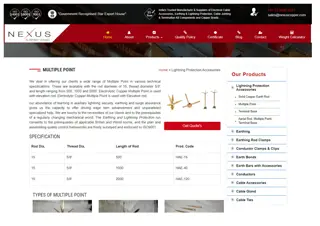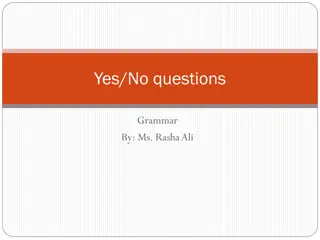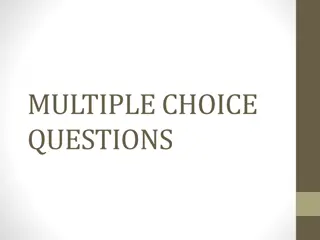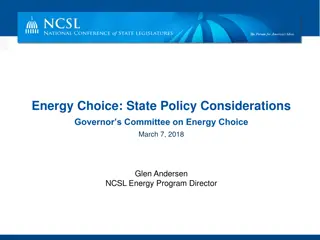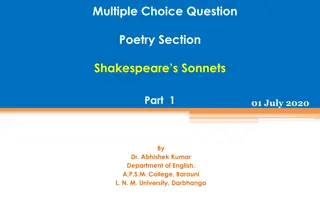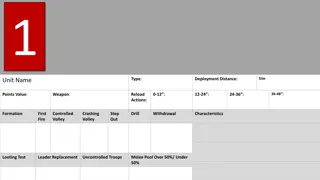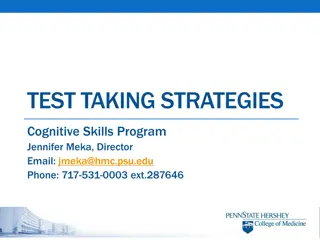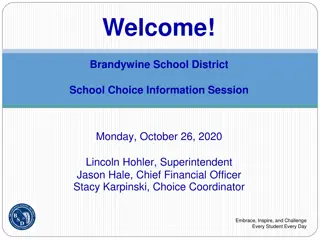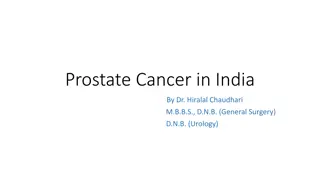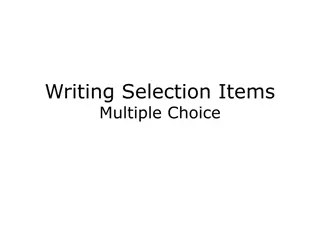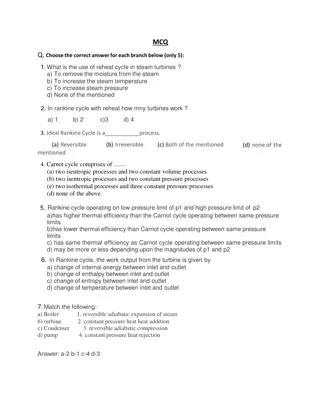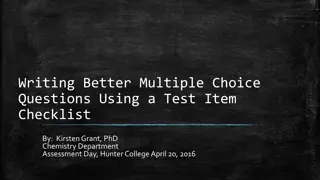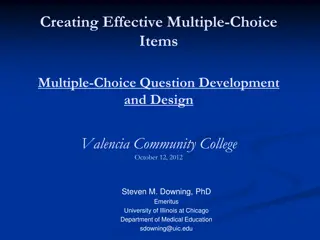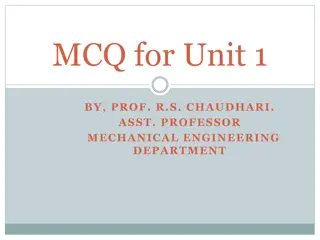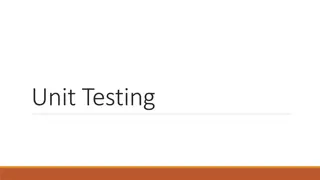Multiple Choice Questions for Unit 1 by Prof. R.S. Chaudhari
This set of multiple-choice questions for Unit 1, created by Assistant Professor R.S. Chaudhari from the Mechanical Engineering Department, covers topics such as wear conditions, safe clutch and bearing designs, frictional torque, uniform pressure conditions, and more. Test your knowledge on these fundamental concepts in mechanical engineering with these thought-provoking questions.
Download Presentation

Please find below an Image/Link to download the presentation.
The content on the website is provided AS IS for your information and personal use only. It may not be sold, licensed, or shared on other websites without obtaining consent from the author. Download presentation by click this link. If you encounter any issues during the download, it is possible that the publisher has removed the file from their server.
E N D
Presentation Transcript
MCQ for Unit 1 BY, PROF. R.S. CHAUDHARI. ASST. PROFESSOR MECHANICAL ENGINEERING DEPARTMENT
Question 1 The uniform wear conditions are used .. a) for maximum power to be transmitted b) for safe design of clutches c) for safe design of bearings d) for overcoming the frictional torque.
Question 2 The uniform pressure conditions are used . a) for maximum power to be transmitted b) for safe design of clutches c) for safe design of bearings d) for overcoming the frictional torque.
Question 3 For safe design of bearing, we assume .. a) maximum power to be transmitted b) safe design of clutches c) safe design of bearings d) overcoming the frictional torque.
Question 4 For safe design of clutches, we assume .. a) uniform pressure conditions b) uniform wear conditions c) Neither uniform pressure nor uniform wear d) All of the above.
Question 5 According to uniform wear theory . a) P = constant b) P r = constant c) P W = constant d) P T = constant
Question 6 In case of foot step bearing, the frictional force under the conditions of uniform wear may be assumed to be acting at . a)r b) r c) 3/2 r d) 2/3 r
Question 7 The ratio of friction torque for uniform pressure to uniform wear for the same dimensions and load is . a) > 1 b) =1 c) < 1 d) =
Question 8 Torque required to overcome the friction between shaft and bearing surface in case of multiple flat collar bearing is .. a)Independent of no of collars b)dependent on radius of collar C)dependent of no of collars D)Non of above .
Question 9 According to uniform wear theory frictional torque transmitted by conical pivot bearing is a) 2/3 W R cosec b) 1/2 W R cosec c) 1/2 W R cos d) W R cosec
Question 10 Frictional torque as per uniform wear theory is . (a) P(R0+Ri) (b) P(R0+Ri) (c) P
Question 11 In case of flat pivot bearing, the rubbing velocity is (a)maximum at the centre of the contact area (b)zero at the centre & maximum at the outer radius (c)uniform throughout the contact area (d) zero at the outer radius
Question 12 The rate of wearing in case of flat pivot bearing is (a)inversely proportional to the pressure intensity (b)directly proportional to the rubbing velocity (c) directly proportional to the pressure intensity (d)both (b) &(c)
Question 13 For calculating the friction power of bearing, the assumptions made in practise are (a)the rate of wearing at the surface is uniform (b) the rubbing velocity is constant (c) the pressure intensity is uniform (d) (a) & (c) only
Question 14 In case of flat pivot bearing, the frictional torque transmitted for uniform pressure as compared to the frictional torque transmitted for uniform wear (a)is more (b)is less (c)is constant (d)may be more or less
Question 15 The frictional torque, transmitted in case of flat pivot bearing for uniform pressure, is equal to (a) WR (b) WR (c) WR (d) WR
Question 16 In case of flat pivot bearing, the frictional torque transmitted for uniform pressure as compared to the frictional torque transmitted for uniform wear Is equal to .. (a) WR (b) WR (c) WR (d) WR
Question 17 The ratio of frictional torque for uniform pressure to the frictional torque transmitted for uniform wear in case of flat pivot, is equal to . (a) 1/3 (b) (c)1.0 (d)
Question 18 The frictional torque, transmitted in case of a flat collar bearing for uniform pressure ,is equal to (a) W (b) (c)(R1+R2) (d)(R1-R2)
Question 19 The frictional torque for the same diameter in a conical bearing is _____ than in a flat bearing. (a) more (b) less (c)equal (d)may be more or less
Question 20 The frictional torque transmitted by a conical collar bearing is _______. (a)less than that of flat collar bearing (b)equal than that of flat collar bearing (c)more than that of flat collar bearing (d)none of the above
Question 21 The frictional torque produced due to friction for same shaft diameter, in conical bearing is ___. (a)less than that for flat bearing (b)equal to that for flat bearing (c)more than that for flat bearing (d) may be more or less depending upon cone angle
Question 22 Choose the wrong statement. (a)The frictional torque transmitted by a shaft fitted with a large number of collers is the same as transmitted by a shaft with one coller. (b)The frictional force for uniform pressure , in case of a flat pivot bearing, can be assumed to be acting at distance of 2/3 of the radius of the shaft from the axis of shaft. (c)when horse power lost in friction is to be determined, uniform pressure is assumed for safe design of bearing (d) The frictional force for uniform pressured, in case of a flat coller bearing, can be assumed to be acting at distance of 1/2 of the sum of internal and external radii of the shaft.
Question 23 The frictional torque transmitted in a conical pivot bearing , concider uniform wear , is ____. (a)1/2 W R cosec (b) 3/2 W R cosec (c) 3/4 W R cosec (d) W R cosec
Question 24 For pivot bearing with r & r as the outer and inner radii & W as the axial load, the frictional torque , assuming uniform pressure is given by ______. (a) 1/2 W (r + r ) (b) 1/2 W (r - r ) (c) 2/3 w( (r13-r23)/(r12 r22)) (d) ) 2/3
Question 25 For coller bearing with r & r as inner and outer radii & W as axial load, assuming uniform wear, is given by ______. (a) 1/2 W (r + r ) (b) 1/2 W (r - r ) (c) 2/3 w( (r13-r23)/(r12 r22)) (d) ) 2/3 w( (r13-r23)/(r12+r22))
Question 26 The ratio of frictional torque produced for uniform wear to that for uniform pressure is ________. (a)1 (b)2/3 (c)4/3 (d)3/4
Question 27 In case of pivot bearing the rate of wear is ______. (a)maxmat the center of contact area (b) zero at the center of contact area (c)uniform throughout the contact area (d) zero at the maximum radius of the contact area
Question 28 The number of collars are provided to carry a fixed axial force in a flat collar bearing _____. (a)to increase torque (b) to decrease torque (c) to decrease intensity of pressure (d) to increase intensity of pressure
Question 29 In flat pivot bearing the total moment of friction force______ a)for uniform wear is greater than that for uniform pressure b) for uniform wear is less than that for uniform pressure c) for uniform wear is equal to that for uniform pressure d) for uniform wear may be more or less and connot be predicted
Question 30 In flat pivot bearing the total power lost in friction ______ a) for uniform wear is greater than that for uniform pressure b) for uniform wear is less than that for uniform pressure c)for uniform wear is same as that for uniform pressure d) for uniform wear may be more or less pressure and connot be predicted
Question 31 The frictional torque produced in case of flat pivot bearing for uniform wear and uniform pressure respectively is (W = total axial load, =co-efficient of friction,r =radius of pivot) a)1/2 W r and 2/3 W r b)2/3 W r and 1/2 W r c)1/3 W r and 1/2 W r d)1/2 W r and 1/3 W r
Question 32 To be on the safe side in design ,the uniform pressure and uniform wear is Assumed respectively_________ A)for power transmitted by friction and power lost due to friction b)For power lost due to friction and power transmitted by friction c)For torque transmitted by friction and friction torque overcome d)None of the above
Question 33 choose the correct statement for safe design a) for power lost in friction uniform wear is assumed b) for power lost in friction uniform pressure is assumed c) for power transmitted due to friction uniform pressure is assumed d) for power transmitted due to friction or lost in friction uniform wear is assumed
Question 34 choose the correct statement for safe design a) for power transmitted by friction uniform wear is assumed b) for powertransmitted friction uniform pressure is assumed c) for power lost in friction and power transmitted uniform wear is assumed d) for power lost in friction and power transmitted uniform pressure is assumed
Question 35 The purpose of providing multiple collars on a flat collar pivot bearing is to a) Establish self sustaining bearing conditions b) Increase the frictional resistance c) Distribute the axial load because of limiting bearing pressures on the bearing d) Increase th e power absorbed by the bearing
Question 36 Frictional torque produced for uniform pressure for conical pivot Bearing having semi angle of cone = is equal to_____ A) W r1/2 B)2 W r1/3 C) W r1/3 D)3 W r1/4
Question 37 Frictional torque developed due to uniform wear for conical Bearing with semi cone angle = is_____ A) W r1/2 B)2 W r1/3 C) W r1/3 D)3 W r1/4
Question 38 In a multi-collared thrust bearing consisting of n collars and Subjected to axial load W,load sheared by each collar is_____ A)W B)W/n C)W/(n-1) D)None of these
Question 39 Brakes are self-energizing when .. A)Frictional torque assists the applied torque. B)Frictional torque opposes the applied torque. C)Frictional torque vanishes. D)None of above.
Question 40 In a differential band brake, as shown in fig.1 the length OA is greater than OB. In order to apply the brake, the force at C should .. A)Be zero. B)Act in downward direction C)Act in upward direction D)None of the above
Question 41 For the brake to be self locking, the force P at C as shown in figure 1 should .. A)Be zero B)Act in downward direction C)Act in upward direction
Question 42 When brakes are applied to all four wheels of a moving car, the distance travelled by the car before it is brought to rest, will be .. A)Maximum b) minimum C)Both a and b d) none of the above
Question 43 Which of the following brakes is commonly used in two wheelers? A)Disc brake B)Band brake C)Internal expanding shoe brake D)A and B
Question 44 Brakes commonly used in trains are brakes A)Band B)Shoe C)Band and block D)Internal expanding shoe
Question 45 In a self locking brake, the force required to apply the brake is A)Minimum B)Maximum C)Zero D)None of the above
Question 46 When the frictional force helps the applied force in applying the brake, the brake is A)Self locking B)Automatic C)Self-energising D)A and C
Question 47 In an internal expanding shoe brake, more than 50% of the total braking torque is supplied by .. A)Leading shoe B)Trailing shoe C)Any of the two D)None of these
Question 48 which of the following is classified a absorption type of dynamometer ? a) prony brake dynamometer b) rope brake dynamometer c) hydraulic dynamometer d) all of above
Question 49 which of the following is classified as transmission type of dynamometer a) prony brake dynamometer b) rope brake dynamometer c) hydraulic dynamometer d) epicyclic dynamometer



